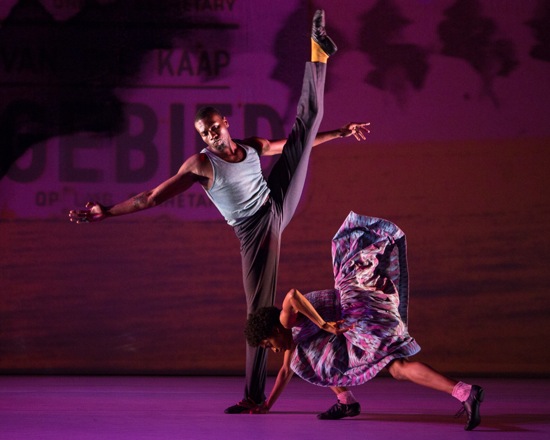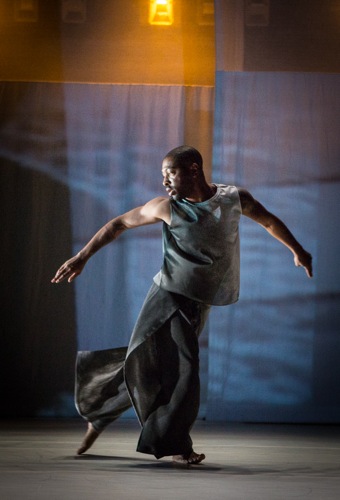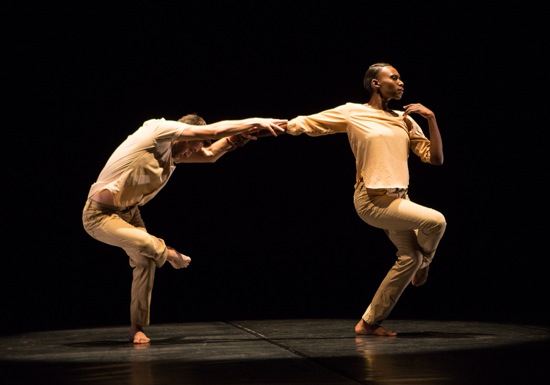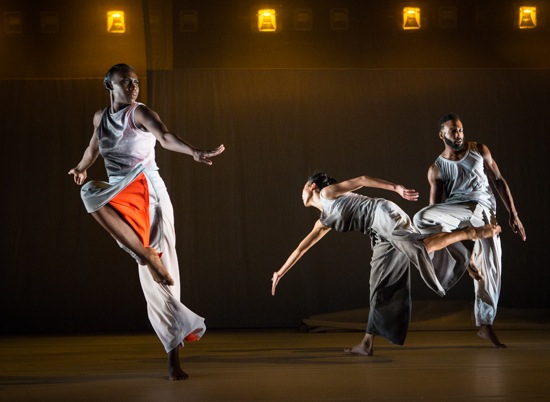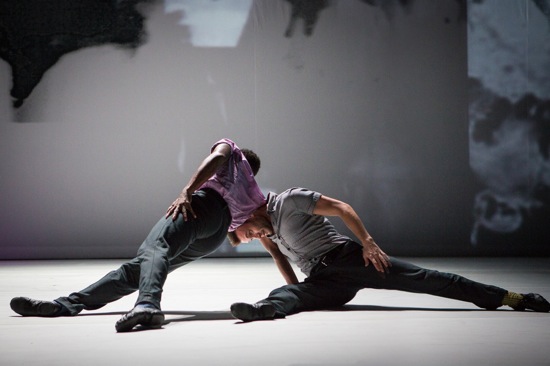Kyle Abraham/Abraham.In.Motion brings three works to the Joyce Theater.
Seated at a piano in a corner of the Joyce Theater, Kris Bowers begins to play a quiet, rippling tune—familiar yet unfamiliar. Beside the instrument and close to the front rows of spectators, Kyle Abraham performs a prelude to his company’s season, never moving outside a muted spotlight’s beam. Just as Bowers dreamily reconfigures “Some Day My Prince Will Come”— making it come apart the way paper does in water and then floating the pieces into proximity—Abraham redesigns the human body, making it move in ways most of us don’t.
He is, of course, not alone among dancer-choreographers in doing this. But his personal movement style provokes different thoughts from those that a display of ballet virtuosity might engender and makes me think how little of our physical capabilities we humans use in our daily lives. Say I reach one hand up to grab a jar of jam from a high shelf; maybe I hike up one shoulder a bit, rise onto tiptoe, but, fixed on my goal, I move efficiently—that is, with a minimum of motion. Kyle Abraham reaches up a hand in empty space, and it emerges from a collaboration of muscles, joints, sinews, and bones that creates impulses that ripple through him, displacing this, untethering that. If you moved like this on the street of an American city, people might worry about you; onstage, Abraham’s complicated fluidity is understood as artistry. He’s not portraying a man falling apart; he’s playing a man teasing himself into staying together. It’s fascinating to watch the interplay he sets up between striking a movement and then sinking into it the way you settle into soft sofa cushion. His arms snake and twist. As the music heats up the tempo, his neck and head get involved; he jerks and jitters, threatening to go out of control. Then he just walks away.
Abraham filters elements of hip-hop, jazz, African forms, and modern dance through his own sensibility and translates the resultant fusion into choreography for his company of seven accomplished and charismatic performers, five of whom appear in his 2011 The Quiet Dance. The beginning is not just quiet, but as silent as it can get. Beautiful Catherine Ellis Kirk is dancing alone in a far corner of the stage, advancing toward the audience along a narrow path, retreating, advancing again. . . . In the lush, three-dimensional welter of movement that she embosses on the air, you can spot some familiar steps, but Abraham renders them unfamiliar. You might be tempted to call one move a turn in attitude; that would be misleading. The impetus, the flow, the weight, and the attendant behavior of the dancer’s arms or gaze escape such terminology.
The Quiet Dance eventually acquires some quiet music. This time Bowers is playing Bill Evans’s take on Leonard Bernstein’s “Some Other Time.” As in the music accompanying Abraham’s Prelude, the melody sneaks around and finds disguises. Penda N’diaye and Matthew Baker appear on the opposite side of the stage in a warmer glow than the one that lighting designer Dan Scully has created for Kirk. When Tamisha Guy and Vinson Fraley Jr. arrive and join N’diaye and Baker, they’re ready to assume the bent-over stance that seems to power things up.
The music turns sweeter, and Abraham’s strategy takes shape. As the four dance, and Kirk continues dancing, she sometimes happens to fall into unison with them and, just as easily return to her own pursuits. So there are these two worlds, although the populations change. The link between them is fragile, sometimes gone before you notice it. There are also contrasts. Once, Kirk gets wild against the others’ calm. Baker and N’diaye dance together, and it’s clear that Abraham enjoys the contrast between them: N’diaye majestically tall, long-legged, and black; Baker, shorter and more compact, white and bearded. They match each other, however, in fluency and ease. When they go, Kirk reprises some of their steps. Guy and Fraley also have a brief duet, and Kirk is at times close to them. In the end, all are onstage and Kirk walks among the others. You can imagine her as a lodestar but also as a remembered teacher, also as an outsider.
Kyle Abraham/Abraham.In.Motion presented a New York premiere at the Joyce. Its title, Absent Matter, resonates with Black Lives Matter, the activist movement that speaks out against the unwarranted shooting deaths of young black men like Trayvon Martin, Michael Brown, and Corey Jones at the hands of the police. Abraham has said that he was also inspired by the violent deaths of musicians associated with hip-hop, such as Tupac Shakur and Biggie Smalls.
This time Bowers works an electric keyboard, while his co-composer, Otis Brown III, handles drums, and Burniss Earl Travis plays bass. Recorded elements by Common, Kanye West, and Kendrick Lamar also figure. The powerful sound score includes voices yelling, calling out, and screaming, while Naima Ramos Chapman’s projected montage of black-and-white film footage shows paraders, rioters, police, and crowds pouring down streets. We pick out words. “I’m just dancing!” Lamar’s “We gon’ be alright.”
Scully has positioned a row of seven amber lamps at the back of the stage, above the curtains that hold the projections. These lights aren’t constantly on. Three may wink out, or fewer, or all.
Periodically, two stagehands come out and strip off the tape that secures four black floor panels—one or two at a time. As they back up, their slow pulling up on a thin length of tape makes a ripping sound. (I think, suddenly of entrails.) When all the panels are folded loosely at the back of the stage, they reveal white undersides (my imagination may have made too much of this).
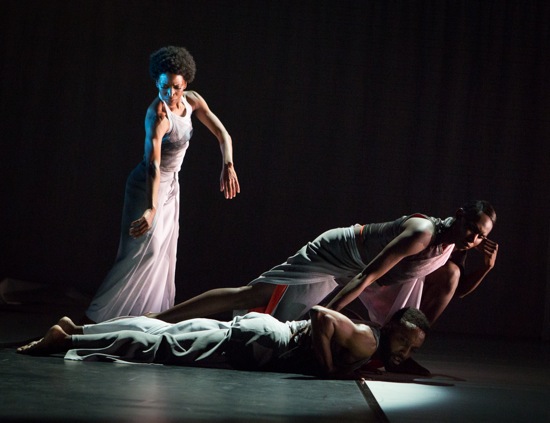
(L to R): Tamisha Guy, Jeremy “Jae” Neal (prone), and Penda N’diaye in Abraham’s Absent Matter. Photo: Yi-Chun Wu
Amid this (and in handsome costumes by Karen Young), the dancers (Guy, N’diaye, Jeremy “Jae” Neal, Connie Shiau, and Abraham) dance. With all their power, beauty, fervency, and intelligence. I’ve noticed before that Abraham shies away from making choreography that directly reflects his social and political concerns. The people onstage approach the complex, dynamically inflected movement as if it were a metaphor for living, not a substitute for words. The only direct reference to the deaths that anger and sadden so many are intermittent tableaux. One performer lies prone or curled on his/her side; another kneels beside the victim, reaching out a hand. A third may stand gazing. Sometimes several people are down. We see no aggressive act preceding this moment, no protest following it, no mourning—only these frozen, ineradicable moments. The last image is of N’diaye alone and fallen. Chiau stares for a moment, then walks away.
The program ended with Abraham’s 2014 The Gettin’, whose projected “Whites Only” signs and others indicate a historic locus of racism: South Africa. It was good to hear again the terrific musicians (Bowers, Brown, Chris Smith, and singer Charenee Wade) cut loose with Robert Glasper’s interpretation of We Insist! Max Roach’s Freedom Now Suite. Especially memorable in The Gettin’: Baker and Neal’s combative, yet tender duet and Shiau’s fever of a solo.

